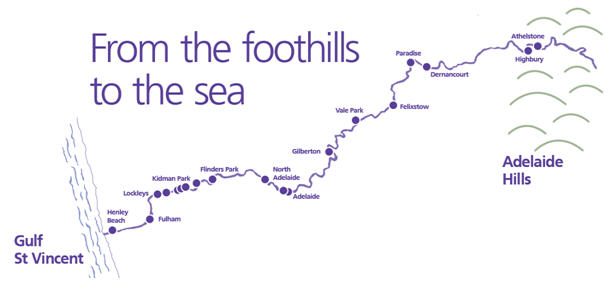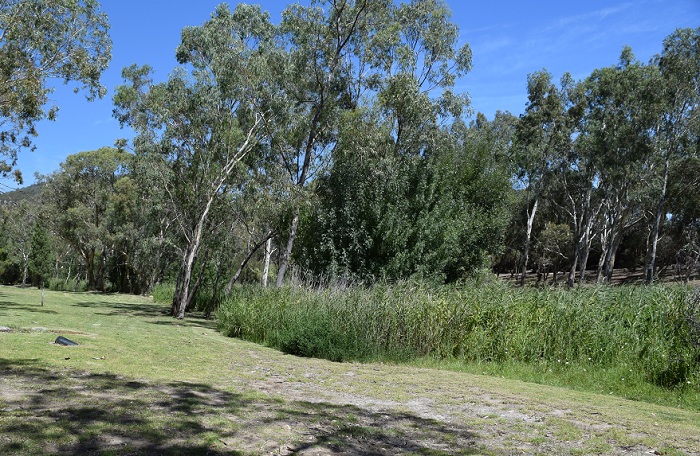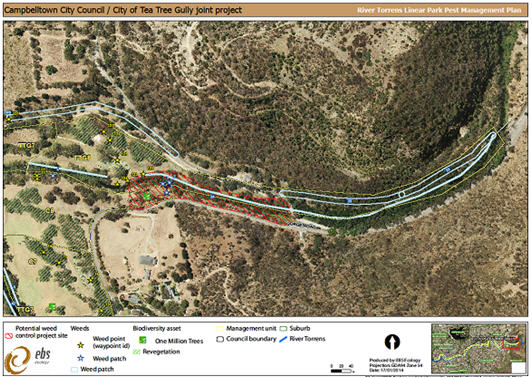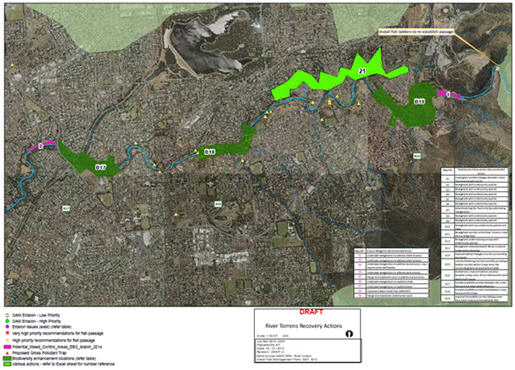River Torrens Recovery Project
What is the project?
This is a joint project between the Adelaide Mount Lofty Ranges NRM Board and 8 metropolitan Councils (including Campbelltown) which aims to improve water quality and biodiversity in the river between the upper reaches above Athelstone and the coast where the water enters the sea.

How much is the project costing?
Works in the priority 1 area of the river corridor in the Cities of Campbelltown and Tea Tree Gully will cost $237,000 collectively.
Who is funding the project?
The Australian Government River Torrens Recovery Program is a federally funded program. $1 million is to be provided over 2 years to improve the environmental health of the River Torrens from the hills face to the sea. Councils are not required to contribute financially to this project.
Campbelltown City Council along with the City of Tea Tree Gully, have been provided funding for a combined project total of $237,000 to undertake works in priority 1 areas of the river corridor.
What outcomes are anticipated?
The environmental outcomes sought from the project are:
- Reduction of nutrient inflows
- Bank stabilisation
- Revegetation
- Weed and feral animal management
- Community engagement and training opportunities

Which parts of the river are being worked on?
Site 1 is located adjacent to Gorge Road, Athelstone and includes land within the City of Tea Tree Gully, Adelaide Hills Council and City of Campbelltown.

Further work will be undertaken at Sites B17 (located between Brian Grove Rd and the corner of Lagonda Drive and Darley Road, Paradise) and B19 (located between the south western end of Nursery Way, Highbury and the north western cnr of Black Hill Conservation Park) in 2015/2016.

What exactly is going to happen on site and when?
Site 1 – Works are anticipated to commence in March 2015 and include:
- Cut / swab and treat the stumps of Ash/ Willow/ Poplar (spring or summer) (using frog-friendly herbicide)
- Chip and dump the biomass of the trees offsite
- Blade brush-cut the bulk of large Blackberry brambles and mulch onsite with brush-cutter (autumn, spring or summer)
- Swab stumps if possible at the time, and/or just spray the regrowth later (using frog-friendly herbicide)
- Spray any Blackberry brambles that are difficult to access with brush-cutter (using frog-friendly herbicide)
- Removal of additional woody weeds (Olives, Boxthorns, Castor Oil etc) in the same manner as Ash
Sites B17 and B19 - Works are anticipated to be undertaken in 2015/2016 and will consist of Weed eradication and revegetation at these sites.
Why are you removing plants?
The autumn leaf drop of exotic trees:
- Smothers aquatic habitat
- Creates barriers to water flow
- Produces localised flooding
- Increases nutrients in the water as a result of the breakdown of organic matter resulting in unsuitable water quality for native aquatic plants and animals
- Promotes algal growth in coastal waters which smothers seagrass leaf blades, reducing the amount of light available for these grasses to photosynthesise and grow
Poplars, ash and willow trees sucker and produce dense growth that can block and divert the flow of water, sometimes leading to erosion and localised flooding. With the removal of these weed species it will encourage natural regeneration of native plants
What will you plant to replace the removed plants?
When the areas have been cleared, initially natural regeneration will be encouraged. The planting of indigenous plants will occur at suitable times during the year. These plant species are naturally occurring in the local area. An ‘Indigenous Plant’ refers to a native plant that naturally occurs in the immediate local area, for example this would mean only a few kilometres from Athelstone, rather than hundreds or thousands of kilometres from this natural range.
Both Councils are committed to providing sustainable landscapes that contribute to biodiversity, manage water resources effectively, reduce energy requirements and improve environmental conditions within the area. Planting Indigenous plants will provide additional habitat resources (e.g. food and shelter) for native fauna including insects, birds, reptiles and mammals
Will the project impact on native wildlife?
It has been determined, from experiences and studies, that areas with a high concentration of exotic shrubs and trees contain few native wildlife populations. If it is the case that any native wildlife is found within these areas, all attempts will be made not to disturb them or all other options will be assessed including relocation options.
Who do I contact if I have concerns regarding this project?
Contact Council’s Manager Trees and Biodiversity, Henry Haavisto on 8366 9285 during business hours.
What will be the impact on water flow?
Removing exotic trees and weeds will reduce blockages and increase water flow capacity. This helps reduce flood risks by increasing the volume of water held in the watercourse and decreasing the time it takes to reach the sea.
Will the works cause erosion / instability of river banks?
All efforts will be made not to cause erosion or instability. The protection of the soil surface will be a priority and the use of mulch cover will help. Areas subject to erosion or instability have been Identified and considered during the planning phase. The strategies of native vegetation retention, planting and natural rehabilitation will reduce potential of erosion. The intent will be to maintain the natural flood carrying capacity of the river.
